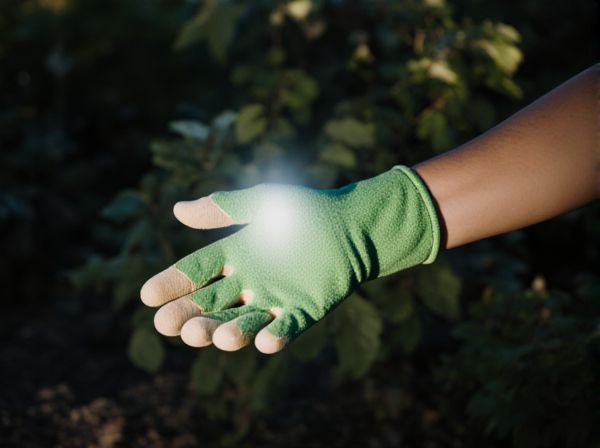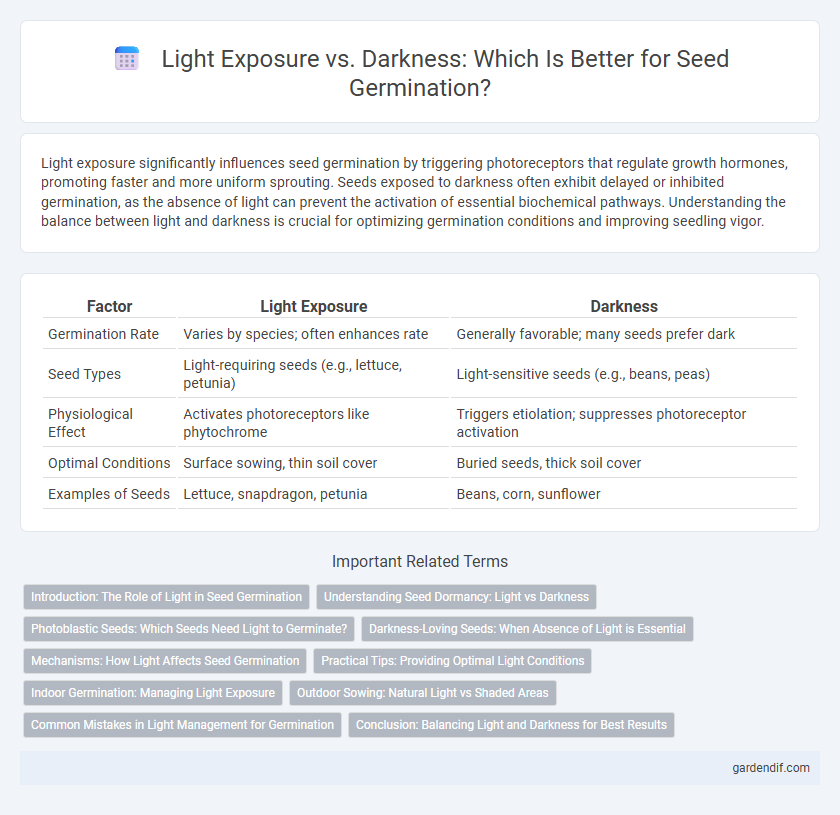
Light exposure vs Darkness Illustration
Light exposure significantly influences seed germination by triggering photoreceptors that regulate growth hormones, promoting faster and more uniform sprouting. Seeds exposed to darkness often exhibit delayed or inhibited germination, as the absence of light can prevent the activation of essential biochemical pathways. Understanding the balance between light and darkness is crucial for optimizing germination conditions and improving seedling vigor.
Table of Comparison
| Factor | Light Exposure | Darkness |
|---|---|---|
| Germination Rate | Varies by species; often enhances rate | Generally favorable; many seeds prefer dark |
| Seed Types | Light-requiring seeds (e.g., lettuce, petunia) | Light-sensitive seeds (e.g., beans, peas) |
| Physiological Effect | Activates photoreceptors like phytochrome | Triggers etiolation; suppresses photoreceptor activation |
| Optimal Conditions | Surface sowing, thin soil cover | Buried seeds, thick soil cover |
| Examples of Seeds | Lettuce, snapdragon, petunia | Beans, corn, sunflower |
Introduction: The Role of Light in Seed Germination
Light exposure plays a crucial role in seed germination by influencing phytochrome-mediated signaling pathways that activate enzymes necessary for embryo growth. Certain seeds, such as lettuce and tomato, require specific light wavelengths, particularly red light, to trigger germination, while others may germinate better in darkness due to their adaptive strategies. Understanding the interaction between light conditions and seed physiology helps optimize germination rates and supports successful plant development.
Understanding Seed Dormancy: Light vs Darkness
Seed dormancy is often influenced by light exposure, with some seeds requiring light to break dormancy while others germinate best in darkness. Photoreceptors such as phytochromes detect light, triggering biochemical pathways that activate germination in light-sensitive seeds. Understanding the specific light or darkness requirements helps optimize germination rates for various plant species.
Photoblastic Seeds: Which Seeds Need Light to Germinate?
Photoblastic seeds require specific light conditions to trigger germination, with positive photoblastic seeds needing exposure to light to initiate the growth process. Examples include lettuce (Lactuca sativa), tobacco (Nicotiana tabacum), and many small-seeded species that rely on light as an environmental cue for optimal germination. In contrast, negative photoblastic seeds such as lettuce varieties sometimes require darkness, highlighting the importance of seed type and light wavelength sensitivity in successful seed germination.
Darkness-Loving Seeds: When Absence of Light is Essential
Darkness-loving seeds, such as lettuce, begonia, and petunia, require complete absence of light to initiate germination, as light exposure can inhibit their enzymatic processes essential for sprouting. These seeds typically rely on soil cover or natural shading to provide optimal dark conditions that trigger hormonal changes promoting embryo growth. Understanding the specific light sensitivity of darkness-loving seeds is crucial for agricultural practices, ensuring higher germination rates and successful crop establishment.
Mechanisms: How Light Affects Seed Germination
Light affects seed germination primarily by activating photoreceptors such as phytochromes, which regulate gene expression linked to growth hormones like gibberellins and abscisic acid. In the presence of specific light wavelengths, phytochromes shift to their active form, triggering biochemical pathways that break seed dormancy and promote embryo development. Conversely, darkness maintains seeds in a dormant state by preventing phytochrome activation, thereby inhibiting germination-related processes.
Practical Tips: Providing Optimal Light Conditions
Seeds generally require specific light conditions for optimal germination, as some species need exposure to light while others germinate best in darkness. Practical tips include placing light-sensitive seeds on the soil surface without covering them and providing a consistent source of indirect sunlight or artificial grow lights. For seeds that prefer darkness, cover them with a thin layer of soil or mulch and keep them in a shaded area to maintain proper moisture and temperature.
Indoor Germination: Managing Light Exposure
Indoor germination requires precise regulation of light exposure to optimize seed sprouting and early seedling development, as some species demand specific photoperiods while others germinate best in darkness. Controlling light intensity, duration, and wavelength using grow lights or shaded covers promotes uniform germination rates and prevents etiolation or stress in young plants. Understanding species-specific light sensitivity ensures successful seedling establishment and maximizes indoor germination efficiency.
Outdoor Sowing: Natural Light vs Shaded Areas
Outdoor sowing reveals that seeds exposed to natural light typically exhibit faster and more uniform germination compared to those sown in shaded areas, where light intensity and duration are reduced. Specific species like lettuce and spinach require light for optimal germination, while others such as beans and peas germinate well in darkness, indicating species-dependent photoreceptive responses. Light exposure outdoors enhances seedling vigor by promoting photosynthesis early in development, whereas shaded sowing often results in elongated, weaker seedlings due to insufficient light.
Common Mistakes in Light Management for Germination
Excessive light exposure during seed germination can cause premature drying of the soil, inhibiting seedling development and reducing overall germination rates. Many growers mistakenly assume all seeds require direct light; however, numerous species need darkness or minimal light to trigger successful germination. Ignoring specific light requirements for different seed types often leads to poor seedling emergence and uneven growth.
Conclusion: Balancing Light and Darkness for Best Results
Optimal germination often requires a precise balance between light exposure and darkness, as various seeds respond differently to these conditions based on their species-specific photoreceptors. While some seeds, like lettuce, need light to trigger sprouting, others, such as beans, germinate best in darkness, emphasizing the importance of tailoring light conditions to seed type. Achieving ideal germination rates involves understanding these light sensitivity patterns to regulate exposure effectively for successful seedling development.
Light exposure vs Darkness Infographic

 gardendif.com
gardendif.com